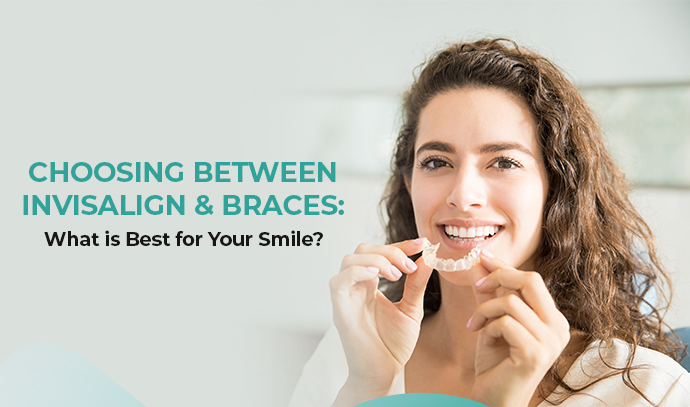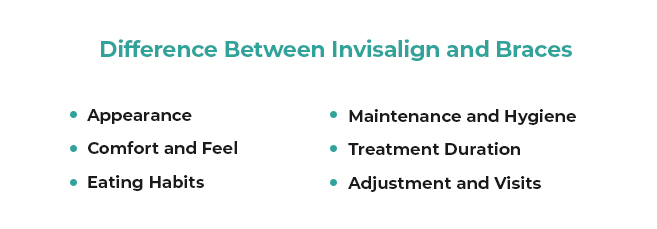
Choosing Between Invisalign and Braces: What is Best for Your Smile?
Are you thinking about straightening your teeth but can’t able to decide between Invisalign and traditional braces? You are not alone! In this blog, we will differentiate between these two popular options and explore what factors you should consider before making a decision. Whether you are a teenager or an adult, understanding these differences will help you to choose the right procedure for your smile. And remember, no matter your choice, Elite Dental is there to help you through your teeth-straightening journey.

Invisalign vs. Braces: What’s The Difference?
When it comes to straightening your teeth, one question arises: ‘ Invisalign vs. Braces: What’s The Difference?’ Let’s explore these options in more detail to help you make an informed decision:
Appearance
- Invisalign: These are clear, almost invisible aligners. These invisible dental aligners are discreet, making them a popular choice for adults and teens who are self-conscious about braces’ look.
- Braces: Traditional braces are more noticeable. They consist of metal brackets and wires, although there are options like ceramic braces that can blend in more with your teeth.
Comfort and Feel
- Invisalign: These aligners are made from smooth material and are custom-made to fit your mouth, making them more comfortable than braces.
- Braces: The wires and brackets can sometimes irritate the inside of your mouth, but many get used to this over time.
Eating Habits
- Invisalign: You can remove the aligners while eating, so there are no food restrictions. However, you need to clean your teeth before wearing them back.
- Braces: Avoid certain foods (like gum, hard candy, or sticky foods) as they can damage the braces. Cleaning your teeth can be more challenging with braces.
Maintenance and Hygiene
- Invisalign: Requires diligent cleaning of both your teeth and the aligners. Not doing so can lead to dental issues.
- Braces: These require careful and thorough cleaning around the brackets and wires, which can be time-consuming.
Treatment Duration
- Invisalign: The treatment length varies, often depending on how regularly you wear the invisible dental aligners. They need to be worn for 20-22 hours a day and changed every one or two weeks.
- Braces: Typically, braces are worn longer, often 18 months to 3 years. But they are working 24/7 to correct your teeth alignment.
Adjustment and Visits
- Invisalign: You will receive several sets of aligners to change every few weeks, reducing the number of dental visits. However, regular check-ups are still needed to monitor progress.
- Braces: Require regular visits to the dentist for adjustments and tightening, which can be monthly.
Factors to Consider When Deciding Between Invisalign and Braces
Choosing between Invisalign and braces is a decision that affects not just your dental health but also your daily life. Here are some more factors to consider to make the best choice for your smile:
Nature of Dental Corrections
- Complex Issues: Braces might be better for more complex dental issues like severe overcrowding, large gaps, or significant bite problems. They offer more forceful correction.
- Mild to Moderate Adjustments: Invisalign is often suitable for less severe adjustments, like slight crookedness, small gaps, or mild overcrowding.
Lifestyle Considerations
- Active Lifestyle: If you play sports or are involved in physical activities, Invisalign’s removable nature makes it a safer option as there is less risk of injury from wires or brackets.
- Eating Habits: If you enjoy foods problematic with braces (like apples, corn on the cob, or chewy candies), Invisalign allows more flexibility as you can remove them while eating.
Cost Aspects
- Budget Options: When discussing dental aligners cost, braces cost less than Invisalign, but this can vary based on individual cases.
- Insurance Coverage: Check with your dental insurance to see what treatments are covered. Some plans cover braces more readily than Invisalign.
Age Factor
- Young Patients: Braces are often recommended for younger patients, especially children and teenagers, who might struggle to maintain and wear Invisalign aligners regularly.
- Adult Patients: Many adults prefer Invisalign for its subtle appearance and less invasive nature.
Maintenance and Care
- Invisalign Maintenance: Regularly cleaning the aligners and your teeth is a routine to establish.
- Braces Maintenance: Requires careful cleaning around brackets and wires, which can be challenging but becomes easier with practice.
Conclusion
Whether Invisalign or braces are better depends on your needs and preferences. Both options have pros and cons, and the choice varies from person to person. At Elite Dental, we are equipped to guide you through either selection, ensuring you get the best treatment for your smile. Our team of experts is here to provide personalised care, whether you choose the clear convenience of Invisalign or the traditional braces route. Let us help you achieve the smile you have always wanted.
FAQs
Can I switch from braces to Invisalign during my treatment?
Answer: In some cases, switching from braces to Invisalign is possible, but it depends on the specific details of your dental situation. Your dentist can advise you if this is a viable option for your treatment plan.
How long does the treatment take for Invisalign compared to braces?
Answer: Treatment time varies for both. Invisalign may take anywhere from 6 to 18 months, while braces might be needed for around 18 months to 3 years. The exact time depends on the complexity of your dental issues.
Are Invisalign aligners difficult to maintain?
Answer: Invisalign aligners require regular cleaning, which is quite straightforward. Rinse them every night and brush them gently to keep them clear and odour-free. Also, maintaining good oral hygiene is crucial.
Is one option more effective than the other?
Answer: Invisalign and braces are effective for teeth straightening, but their effectiveness can vary depending on the specific dental issues being addressed. Braces can be more suitable for complex alignments, while Invisalign is effective for mild to moderate cases. Your dentist can provide the best recommendation based on your needs.
Have Dental Problem : Call us
CALICUT: +91 9745 072 555,
KOCHI: +91 9567 124 888
KANNUR: +91 9645874777
or make an Appointment
Take a smiling selfie and we'll Simulate your new smile See What Invisalign treatment could do for you!




